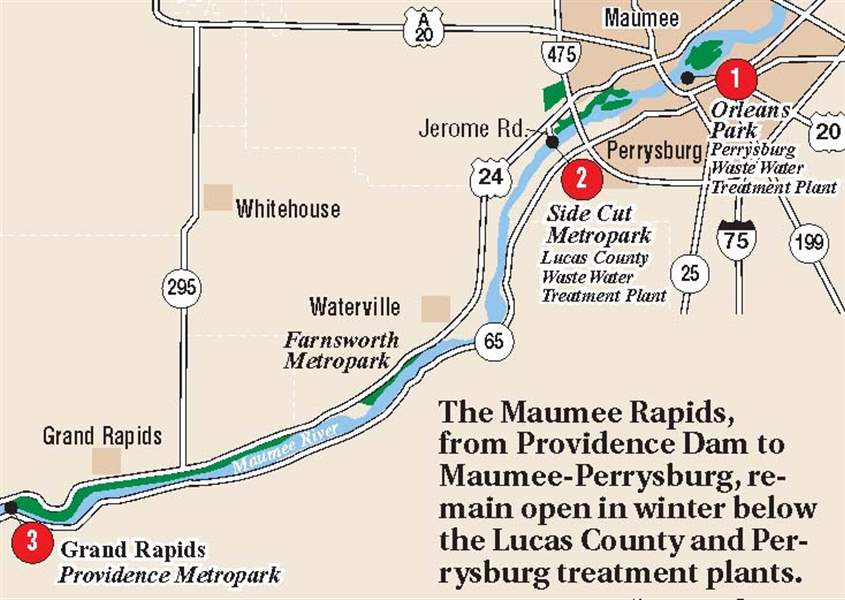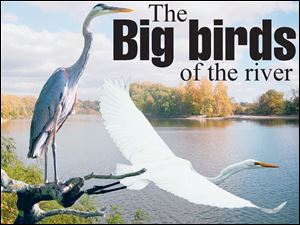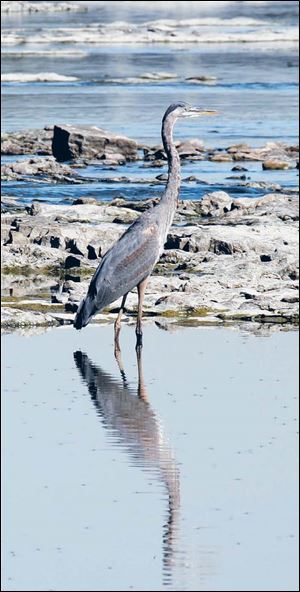
Toledo Magazine: Outdoors Page: The big birds of the river
11/29/2009

This photo collage depicts a great blue heron on a perch and a great egret on the wing, with the islands across from Orleans Park in the background.
Herons and egrets rule this area's river shallows
The famed rapids of the Maumee River are a bigbird magnet, apologies to the large, yellow-feathered character of Sesame Street fame.
When the river flow is running low there, even right into winter at certain venues, you can expect to be treated to sights of great blue herons, great egrets, and green herons among the wading birds. Underfoot you may find solitary sandpipers and killdeer among shorebirds, even rare gulls.
“Almost anything can pop up in those shallow rapids,” says Mark Plessner, a naturalist for the Metroparks of the Toledo Area and a fan of the rapids and its fishstalking avian denizens.

A great blue heron poses statuelike at Jerome Road rapids.
The 130-mile-long Maumee, which stretches from Fort Wayne to Toledo, is a northeast-southwest migratory corridor for all manner of birds. The fall migration begins in August and by now is mostly done. But don't despair.
At November's end, wherever there is open water, expect still to view the herons and egrets and even mute swans, or, as Mr. Plessner puts it, “a lot of big stuff that really catches people's eyes.”
He advises, too, not to spend all your time looking down. Overhead you may see bald eagles and even ospreys, once known as fish hawks for their angling prowess.
“These are great birds, diving into the water to catch fish to eat,”the naturalist says of the crookwinged osprey.
In the coming winter months the rapids, with their faster-moving water, do not freeze as quickly, and the open water attracts the wading birds. The warm-water outflows of the wastewater treatment plants of Lucas County, at the foot of Jerome Road, and Perrysburg, at Orleans Park, prolong open-water patches for most if not all of the winter.
Mr. Plessner finds it all amazing.

“I'd hate to have come into this world as a wading bird, such as a great blue heron, standing in that cold water, waiting for lunch to come by.”
The naturalist likes, too, to interject a myth-buster here: “A lot of people think that these big wading birds stab fish with their bills. They actually catch fish in their bills. If you study them you'll actually see them tossing the fish into the air so that it comes down head-first so they can swallow it.”
The bird-watching opportunities of the rapids are afforded by the geology of the watershed. Mr. Plessner notes that for the 100 miles of the Maumee between the Ohio-Indiana line and Maumee Bay, the average fall is just 1.3 feet per mile, or nearly flat.
But between the Providence Dam at Grand Rapids and Jerome Road above Maumee-Perrysburg, the fall is three times as much per mile. “So we've got very shallow, very fast-moving water there.” In a word, rapids — filled with churning water and air bubbles.
“I affectionately tell people that the more bubbles, the more bugs, the more [smallmouth] bass, the more birds. That's why it's such a great place to visit.”
So drop by for a visit, watch, and see. Notes Mr. Plessner: “These birds will stay here as long as there is open water and they can find food.”